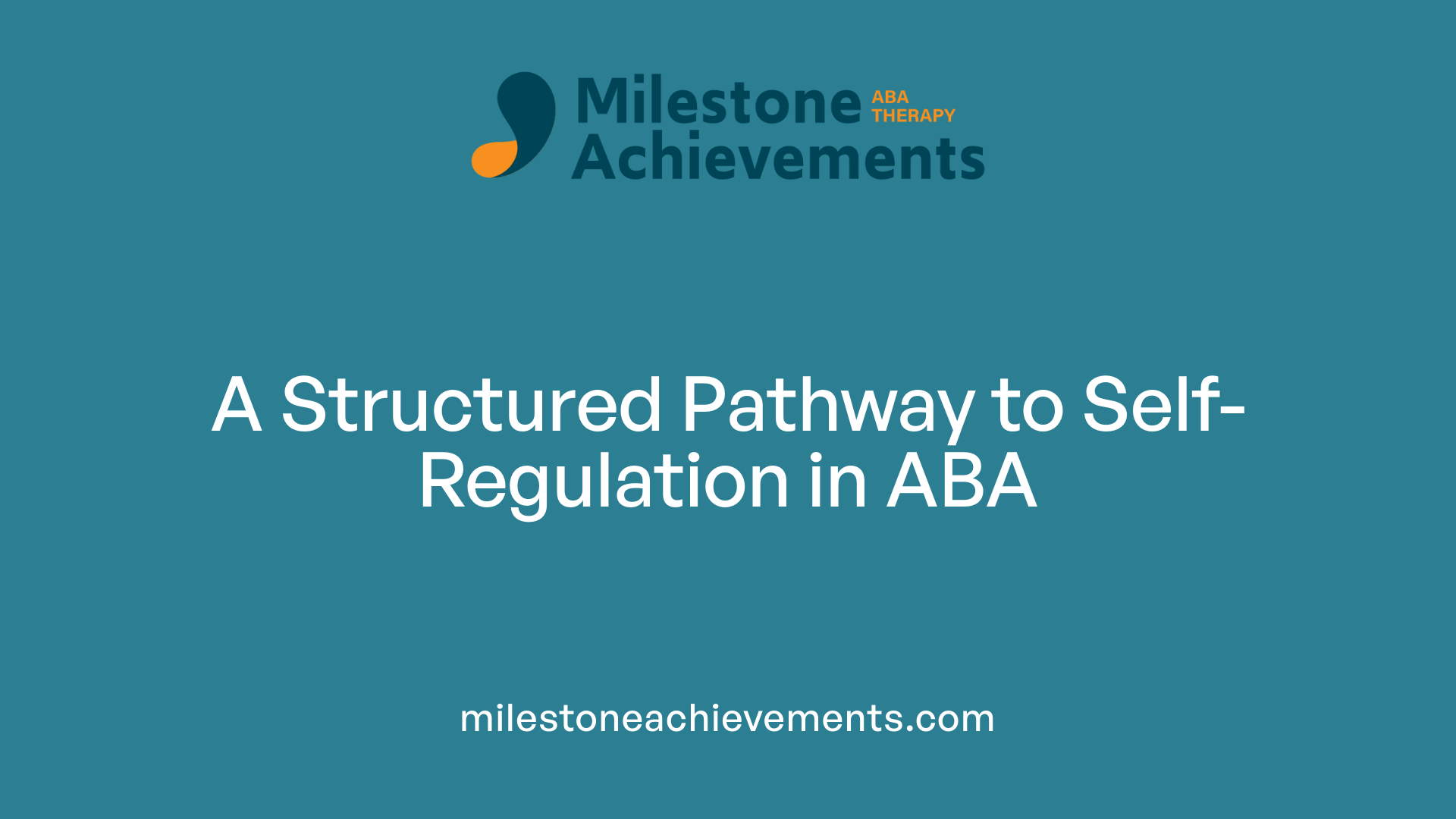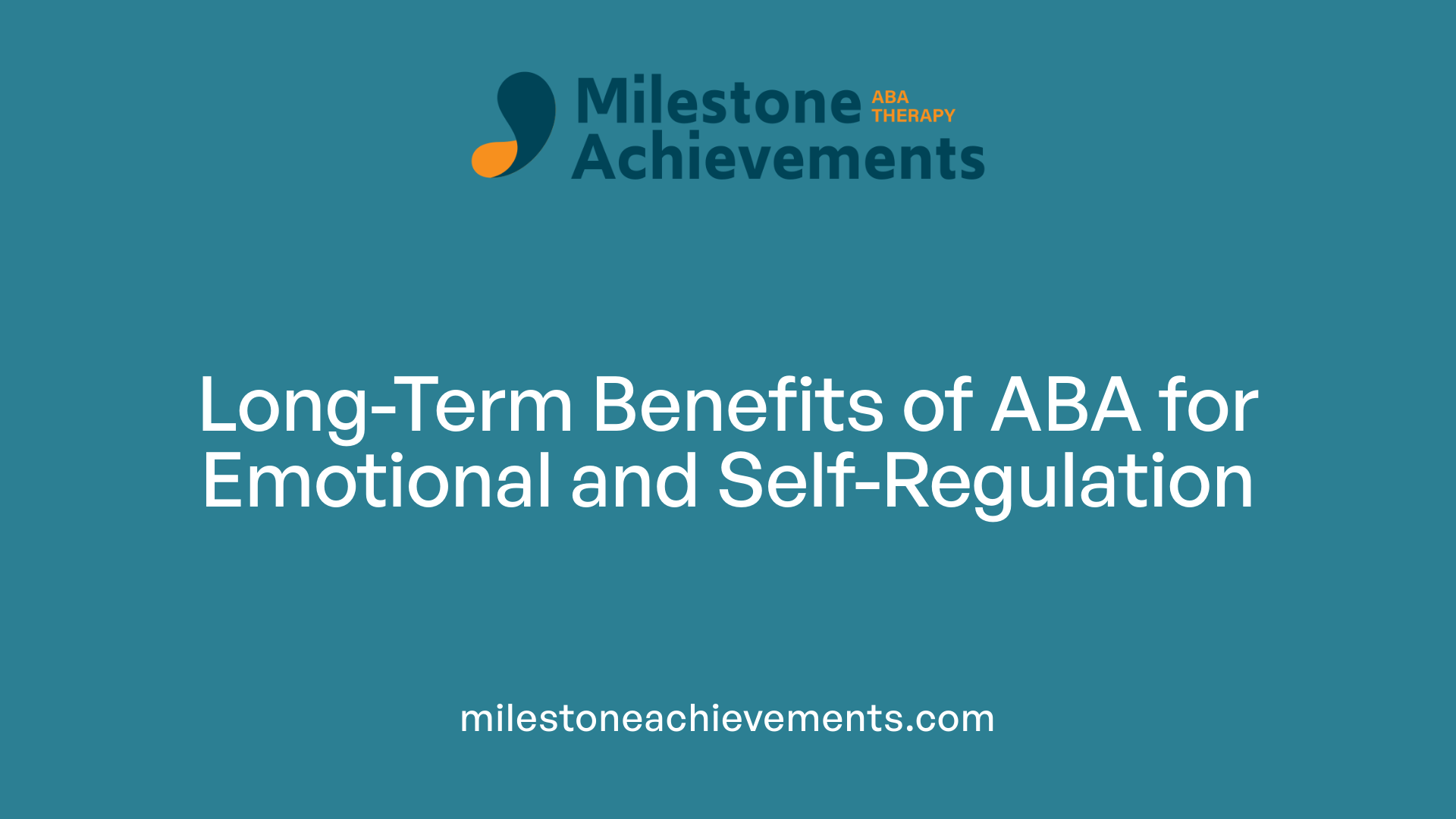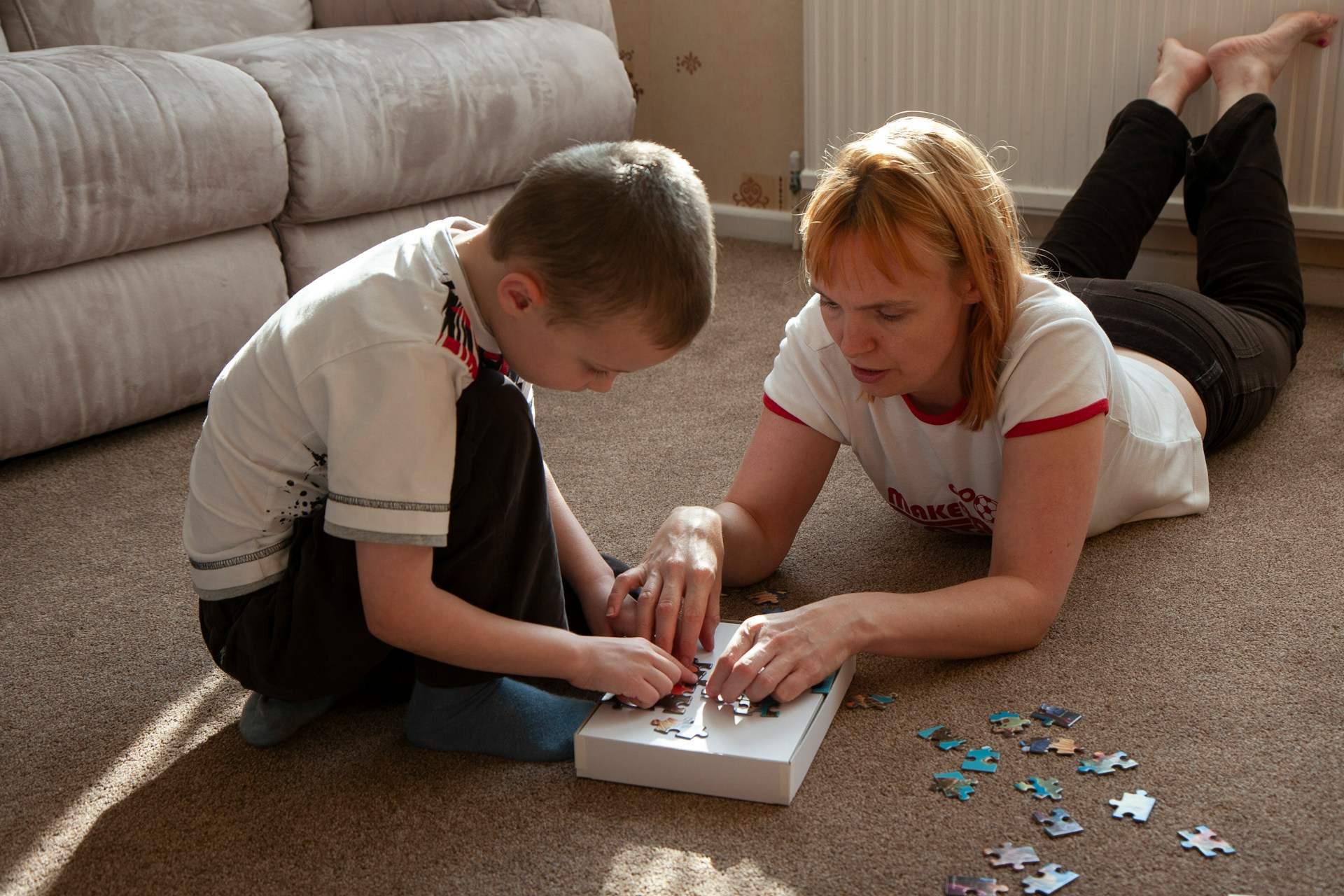
How ABA Therapy Helps with Self-Regulation in Autism
Building Emotional Resilience Through Targeted Interventions
Understanding the Impact of ABA on Self-Regulation in Autism
Autism spectrum disorder presents unique challenges in emotional and behavioral regulation. Applied Behavior Analysis (ABA) has proven to be a comprehensive and effective approach to help autistic individuals develop critical self-regulation skills that enhance their independence and quality of life. This article explores how ABA therapy supports self-regulation, the techniques employed, its benefits, and safety considerations for successful implementation.
ABA Therapy’s Systematic Approach to Self-Regulation

How does ABA therapy support self-regulation in children and individuals with autism?
ABA therapy is designed to help children and individuals with autism develop better control over their emotions, behaviors, and reactions. It achieves this through personalized behavioral techniques that focus on teaching individual skills such as emotional awareness, impulse control, and appropriate responses. Therapists use strategies like positive reinforcement, modeling, prompts, and shaping to encourage healthy behaviors.
By examining the antecedents (triggers) and consequences of actions within the A-B-C (antecedent-behavior-consequence) framework, ABA helps identify what causes certain reactions. This understanding allows therapists to create customized coping strategies, including using visual supports, social stories, and sensory tools that address sensory sensitivities and emotional challenges typical in autism.
In addition, ABA programs incorporate sensory and self-regulation strategies—such as structured transitions, visual schedules, and calming activities—to help manage sensory overload and emotional responses.
The systematic approach of ABA aims to improve a person’s ability to self-regulate, thereby promoting independence, emotional stability, and enhanced social functioning. These methods empower individuals to handle daily challenges more effectively, leading to improved overall quality of life.
How does ABA therapy enhance self-regulation skills through its mechanisms?
ABA therapy boosts self-regulation by gradually teaching children to respond to environmental stimuli in appropriate ways. Through reinforcement and targeted skill-building, children learn to control their impulses and emotions. Functional assessments play a vital role in identifying specific triggers for maladaptive behaviors, allowing intervention plans to be tailored to each child.
ABA strengthens cognitive regulation by teaching skills such as problem-solving, attention control, and behavioral flexibility, often using routines, visual supports, and structured environments. Techniques like functional communication training help reduce aggressive or self-injurious behaviors by replacing them with appropriate, purposeful communication.
Furthermore, ABA supports sensory integration strategies, mindfulness practices, and other complementary approaches, creating a comprehensive framework for building self-regulation abilities. These strategies collectively foster emotional resilience, helping children adapt better to changes and stressors.
What role does ABA therapy play in teaching self-management and emotional control?
In teaching self-management and emotional control, ABA employs a variety of systematic, evidence-based methods. These include setting clear goals, teaching self-monitoring techniques, and encouraging self-evaluation and self-reinforcement. Breaking complex behaviors into smaller, manageable steps makes learning more accessible.
Tools like social stories, visual aids, and environmental modifications are used to help individuals recognize triggers and respond appropriately in emotional situations. Therapists model desired behaviors, provide prompts, and gradually fade support to foster independence.
By making these strategies part of daily routines, ABA helps individuals develop skills in emotional regulation, reduce problem behaviors, and gain better control over their reactions.
This comprehensive focus on self-awareness and self-regulation supports learners in achieving greater independence and adaptive functioning across social, academic, and daily activities. Ultimately, ABA’s structured and personalized approach empowers individuals with autism to manage their emotions better, leading to improved mental health and overall quality of life.
| Aspect | Techniques/Strategies | Outcomes |
|---|---|---|
| Emotional awareness | Visual supports, social stories, mindfulness practices | Improved recognition and expression of emotions |
| Trigger identification | Antecedent analysis, sensory assessments | Better understanding of emotional triggers |
| Response training | Modeling, role-playing, prompts | Appropriate emotional responses |
| Self-management reinforcement | Goal setting, self-monitoring, token systems | Increased independence and self-control |
| Sensory regulation | Sensory gyms, tailored sensory input, calming activities | Reduced overload, better focus |
Understanding and supporting self-regulation in autism involves an array of strategies rooted in ABA’s systematic framework. Together, these techniques help individuals develop resilience, emotional stability, and the skills necessary for independent, fulfilling lives.
Behavioral Techniques That Foster Emotional Stability

What techniques and strategies are used in ABA therapy to improve self-regulation?
ABA therapy employs a variety of approaches to help individuals develop better self-control and emotional responses. Central to these techniques are positive reinforcement, modeling, prompting, and shaping behaviors. Positive reinforcement involves rewarding desired behaviors to increase their frequency, making it more likely for the individual to repeat them.
Modeling and prompting provide demonstrations and cues to guide appropriate responses, helping learners imitate healthy behaviors and emotions. Self-management strategies are also vital; they empower individuals to set personal goals, monitor their progress, and reinforce their own behaviors using tools like checklists, timers, or tokens.
Visual supports, such as emotion charts, scheduled routines, and calming tools, help individuals recognize and manage their feelings. Sensory integration activities and environmental modifications address sensory sensitivities, promoting stability and focus. Mindfulness exercises like deep breathing, guided imagery, and sensory-based relaxation techniques further support emotional regulation.
Together, these strategies foster increased self-awareness and independence. By integrating these techniques, ABA therapy aims for sustained improvements not only in emotional regulation but also across social, academic, and daily activities.
Use of positive reinforcement, modeling, prompting, and shaping
Positive reinforcement remains a cornerstone of ABA in promoting emotional and behavioral growth. Rewards such as praise, tokens, or preferred activities encourage the continuation of desirable responses. Modeling provides a clear example of appropriate emotional expression or social interactions, giving the individual a concrete reference.
Prompting involves verbal cues, gestures, or physical guidance to initiate the correct response, gradually reducing assistance as the individual learns. Shaping gradually reinforces successive approximations toward the target behavior, helping develop complex skills such as managing frustration or expressing feelings appropriately.
The combination of these techniques not only enhances skill acquisition but also ensures that behaviors are maintained over time and across settings, supporting long-term emotional resilience.
Benefits of sensory activities and mindfulness exercises in ABA
Sensory activities and mindfulness exercises are complementary components that significantly enhance emotional stability within ABA programs. Sensory integration activities, such as engaging with sensory gyms or tailored sensory inputs, help children manage overload caused by sensitivities to sights, sounds, or touch. These activities aim to normalize arousal levels, increase focus, and enable smoother transitions between tasks.
Mindfulness practices, including deep breathing, guided visualizations, and relaxation exercises, cultivate emotional awareness and promote self-regulation. When children learn to recognize their emotional states and use calming techniques, they become more resilient against stress and anxiety.
Both sensory and mindfulness interventions teach children to self-regulate effectively by providing tools that manage overstimulation, reduce emotional outbursts, and foster a sense of calm. These strategies contribute to a more consistent ability to handle emotional and sensory challenges in various environments, leading to improved overall functioning and well-being.
| Strategy | Description | Practical Example |
|---|---|---|
| Positive Reinforcement | Reward system that encourages desired behaviors | Giving praise or tokens when a child successfully calms down after an upset |
| Modeling | Demonstrating appropriate responses for imitation | Therapist showing emotional control during a tense moment |
| Prompting | Providing cues to guide behavior | Using a visual cue card to prompt a child to use coping strategies |
| Shaping | Reinforcing successive improvements | Encouraging gradual progress in managing anger with step-by-step rewards |
| Sensory Activities | Activities that engage sensory processing | Playing with textured materials or swinging to soothe overstimulation |
| Mindfulness Exercises | Techniques to promote awareness and calm | Guided deep breathing or visualization sessions |
How do sensory activities and mindfulness support self-regulation?
Sensory activities help children with autism manage their sensory overloads by providing controlled, purposeful sensory input tailored to their needs. Regular engagement in sensory processing can decrease sensitivity and increase focus, enabling better participation in daily routines.
Mindfulness exercises foster emotional awareness and teach children to recognize and label their feelings. These practices promote a sense of calm and resilience, making it easier for children to respond adaptively to stress and emotional triggers.
Both approaches support the development of a self-regulation toolkit that enhances emotional strength, reduces anxiety, and promotes healthier interactions. When integrated into ABA therapy, sensory activities and mindfulness foster a balanced emotional state, resulting in improved social relationships and overall quality of life.
Developing Self-Management Skills Through ABA

How does ABA therapy support self-management and emotional regulation?
ABA therapy plays a fundamental role in helping individuals with autism develop self-management and emotional control skills. Therapists use proven strategies such as setting specific goals, self-monitoring behaviors, and rewarding progress. These techniques involve breaking complex behaviors into easier steps, modeling appropriate responses, and gradually reducing prompts to foster independence.
Visual aids like social stories and charts help individuals recognize their emotional triggers and choose suitable responses. Often, the therapy is tailored to meet each person's unique needs, addressing their strengths and challenges.
By consistently applying these approaches, ABA supports learners in increasing self-awareness, understanding their emotions, and managing them effectively. This leads to fewer problem behaviors, better social interactions, and improved functioning across various life areas.
Overall, ABA helps individuals recognize their emotional states, control their reactions, and develop skills that promote independence and resilience.
How do personalized self-management plans foster independence in individuals with autism?
Creating personalized self-management plans is crucial for nurturing independence among people with autism. These plans generally include clear goals that define what the individual aims to achieve, such as managing frustration or completing daily routines.
Environmental adjustments are made to facilitate learning—this might include visual schedules, timers, and checklists—tools that enable individuals to monitor and regulate their actions. For example, a visual timer can help a child stay focused on a task or transition smoothly between activities.
Learners are initially supported by therapists who guide them through the process. As they become more confident, they take an active role by recording their behaviors, assessing their progress, and using self-rewards like tokens or privileges.
This ongoing involvement builds motivation and promotes internal control. When caregivers are involved, these skills often transfer across settings, leading to greater daily independence, emotional stability, and self-confidence.
| Aspect | Description | Benefit |
|---|---|---|
| Goal Setting | Clear, achievable targets | Motivation and direction |
| Visual Tools | Schedules, timers, checklists | Enhanced self-monitoring |
| Active Participation | Learners record behaviors, evaluate progress | Builds confidence and responsibility |
| Reinforcement Techniques | Rewards, tokens, privileges | Promotes continued effort and persistence |
| Family and Caregiver Role | Support and reinforcement across environments | Skill generalization and consistency |
Summarized Table of Self-Management Strategies in ABA for Autism
| Strategy | Purpose | How It's Used |
|---|---|---|
| Goal Setting | Clarifies what needs to be accomplished | Setting specific, measurable goals |
| Self-Monitoring | Tracks own behavior for awareness | Using charts, logs, visual aids |
| Self-Evaluation | Reflects on progress and adjusts behaviors | Reviewing data, adjusting strategies |
| Reinforcement | Encourages positive behavior and motivation | Rewards like tokens, privileges |
| Environmental Modifications | Supports independence and focus | Visual cues, dedicated routines |
ABA therapy’s emphasis on individualized plans and systematic data collection helps ensure that each person’s progress is monitored and supported. These strategies not only foster independence but also nurture emotional regulation, leading to a more adaptable and resilient individual.
Ensuring Safe and Ethical Implementation of ABA

What safety considerations and guidelines are essential when implementing ABA therapy for self-regulation?
Implementing ABA therapy for self-regulation requires careful attention to safety to ensure it benefits the child without unintended harm. Visual aids, social stories, and role-playing exercises help teach safety rules tailored to each child's developmental level. These tools make safety instructions clearer and easier to generalize across different settings.
Strategies like systematic desensitization and visual supports aid children in understanding safety procedures, reducing anxiety about new or challenging situations. Clear, concrete instructions are vital to prevent misunderstandings. Active supervision during therapy sessions, at home, and in community settings helps quickly address any safety concerns.
Childproofing environments—both indoors and outdoors—reduces hazards. For example, securing dangerous objects or installing locks ensures a child's safety while fostering independence.
Using identification tools such as GPS trackers or medical IDs can prevent wandering—a common safety risk for children with autism. These tools enable caregivers and first responders to locate children swiftly if needed.
Collaboration with caregivers, educators, and emergency responders ensures consistent safety messaging and emergency preparedness plans. Regular practice of safety routines, positive reinforcement for safe behaviors, and personalized safety plans, including water safety and online safety education, further support safe independence.
Overall, these measures mitigate risks effectively and promote a secure environment for developing self-regulation skills.
How can caregivers and practitioners ensure ethical and safe ABA practices?
Maintaining ethical practices in ABA therapy hinges on adhering to established professional guidelines that emphasize safety, dignity, and individualized treatment. Caregivers and practitioners should focus on developing intervention plans that teach useful, meaningful skills aligned with each child's strengths and needs.
Avoidance of harmful practices such as physical punishment is crucial. Educational programs must prioritize positive reinforcement strategies that motivate without causing distress or trauma. Efforts to encourage neurotypical behavior at the expense of the child’s identity are unethical and should be actively avoided.
Parent involvement enhances transparency and effectiveness. Caregivers should be encouraged to attend therapy sessions, participate in training, and monitor interventions closely. This active participation allows for reinforcement of skills at home and provides valuable feedback.
Regular assessments and ongoing data collection are essential. Qualified behavior analysts review progress, modify strategies as needed, and ensure interventions remain appropriate and safe.
Open communication that respects the child's dignity and considers cultural and individual preferences is the cornerstone of ethical practice. Respecting a child's comfort levels and autonomy fosters a safe therapeutic environment.
In sum, following these guidelines ensures ABA therapy remains safe, respectful, and tailored to foster positive growth.
| Aspect | Detail | Additional Notes |
|---|---|---|
| Safety Measures | Visual supports, supervision, environment-proofing, identification tools | Critical for preventing accidents and emergencies |
| Ethical Guidelines | Individualized plans, positive reinforcement, respect for autonomy | Prioritize child's dignity and well-being |
| Parental Role | Active participation, monitoring, collaboration | Enhances safety and therapy effectiveness |
| Continuous Oversight | Regular assessments, data review, therapist supervision | Ensures safety and progress |
| Cultural Respect | Consider child and family preferences | Important for ethical adherence |
By combining these safety and ethical practices, ABA therapy can provide a secure and respectful environment that promotes meaningful development for children with autism.
Long-Term Gains and Broader Impact of ABA’s Self-Regulation Support

What are the long-term benefits of ABA therapy for emotional management and self-regulation in autism?
ABA therapy provides lasting improvements in emotional resilience and self-regulation for individuals with autism. Over time, children learn to better recognize and manage their emotions through structured techniques that teach coping strategies and emotional understanding. This leads to decreased anxiety and enhances self-esteem, creating a stable emotional foundation.
Developing these skills not only improves daily emotional responses but also boosts social interactions and problem-solving abilities. As children grow, consistent reinforcement of positive behaviors promotes independence in daily routines and decision-making.
Furthermore, these gains support meaningful relationships and open doors to better academic and vocational outcomes. The long-term effect is a higher capacity for autonomy, allowing individuals to navigate diverse settings with confidence and resilience, substantially elevating their overall quality of life.
How does the integration of ABA with other therapeutic modalities influence self-regulation outcomes?
Combining ABA with therapies like Cognitive Behavioral Therapy (CBT), Dialectical Behavior Therapy (DBT), and self-regulation techniques amplifies the approach's effectiveness. These modalities complement ABA’s focus on reinforcement and behavioral skill-building with CBT's cognitive restructuring, DBT’s emphasis on emotional regulation, and sensory-based therapies.
This integrated approach addresses multiple facets of self-regulation—emotional, cognitive, and sensory—more comprehensively. For example, mindfulness exercises and yoga incorporated alongside ABA techniques enhance self-awareness and self-control.
The synergy from such combinations fosters adaptable, sustainable self-regulation skills across various environments and stages of life. Children and adults can better manage triggers, reduce emotional intensity, and apply coping strategies flexibly in real-world situations.
What role do families and caregivers play in sustaining ABA’s benefits for self-regulation?
Families and caregivers are central to maintaining and extending the benefits of ABA therapy. Their active participation ensures that learned skills are reinforced consistently at home and other settings. They are involved through training, observation, and direct implementation of strategies like visual supports, routines, and reinforcement systems.
By serving as role models and providing ongoing emotional and behavioral support, caregivers help children apply coping mechanisms in everyday life. Their collaboration with therapists ensures that interventions are tailored and adaptable, keeping progress on track.
Sustained engagement by families creates a supportive environment where emotional resilience and independence can flourish. Long-term success in self-regulation and overall development depends heavily on this partnership, which nurtures skills beyond the therapy sessions and promotes a thriving, adaptive, autonomous individual.
Fostering Independence for a Better Future
ABA therapy's comprehensive and tailored approach significantly enhances self-regulation skills in individuals with autism. Through evidence-based techniques such as reinforcement, modeling, sensory integration, and self-management strategies, ABA helps children develop emotional awareness, impulse control, and adaptive responses. The involvement of families, safety considerations, and integration with other therapies create a supportive framework that nurtures each individual’s growth. As a result, autistic individuals can achieve greater independence, improved social relationships, and a higher overall quality of life, illustrating the profound impact of ABA on fostering resilience and adaptive functioning for a brighter future.
References
- 7 Surprising Benefits of ABA Therapy for Kids You Need to Know
- ABA Therapy and Self-Regulation Skills - heyasd.com
- ABA Therapy's Role in Emotional Regulation
- Autism and Self-Regulation: Why It Matters
- Applied Behaviour Analysis (ABA) and autistic children
- What is Self-Management in ABA Therapy?
- Can ABA Therapy Help Manage Challenging Behaviors in Autism?


Partner with us on your child's journey
Milestone Achievements offers evidence-based ABA therapy to help children with autism reach their full potential. Together we’ll set meaningful goals and celebrate progress every step of the way.
Start ABA Services Today





